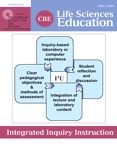Teaching Skeptical Inquiry
A new political season is upon us, and surely it will provide plenty of new examples for me to use during my first week of class. For more than two decades, I have spent at least the first week of my introductory biology course discussing human population growth, its underlying causes, and its environmental ramifications. I always begin with the website www.census.gov/main/www/popclock.html (along with an overhead of the same page on the first day of the previous semester). This leads to a discussion of: what the numbers mean (expressed down to the unit level) and just how reliable they are; who is responsible for these numbers and what their biases might be; and alternative predictions to consider. Of course, here we are talking about government agencies, but the same kinds of data surround us in our daily lives. The ensuing discussion is my opening for bringing up examples from advertising, commercials, and, of course, politics, especially as they relate to science. I encourage this kind of questioning throughout the remainder of the course, especially when I can use examples illustrating how such questioning led to changes in our understanding of science. What I have never done, however, is to systematically analyze the underlying problems students face when dealing with science and scientific controversies. That is what Seethaler has done in Lies, Damned Lies, and Science. She identifies 10 tools, each one the subject of a chapter, that students can use to evaluate not only scientific controversies, but also science-related claims in the media and elsewhere. They are, in fact, the steps to achieving critical, skeptical, thinking.

Each chapter presents relevant examples and identifies common myths (misconceptions) associated with the chapter topic. Two of my favorite myths are in the first chapter, “Potions, Plot, Personalities: Understand How Science Progresses and Why Scientists Sometimes Disagree.” Myth 3 is that “Science is the progressive accumulation of new facts.” Of course, this is how scientific understanding usually grows, but at some point there often comes contradictory evidence, and that is when exciting new ideas germinate and grow, replacing or modifying what was formerly believed. The beauty of a historical approach to selected topics is that we can demonstrate this conceptual shift in class. For instance, prior to the human genome project, we understood that humans had about 100,000 genes. It now looks like about a quarter of that number is a more accurate assessment. Myth 5 is “The publication of findings is the endpoint of the scientific process.” We reinforce this with cookbook labs that are finished at the end of the period and even with undergraduate researchers who are “finished” when they have delivered their poster or presentation. For most of us, it was not until graduate school that we learned the joy of science is discovering many new questions for each question we have answered; this is what we should strive to pass on to our students.
The other chapters focus on identifying: 1) stakeholders on both sides of an issue; 2) the other side of the story—the cons as well as the pros; 3) the trade-offs involved in various alternatives; 4) cause versus coincidence; 5) how broadly or narrowly conclusions may be applied; 6) misleading or meaningless statistics or quantitative data; 7) ethical, moral, or social constraints; 8) psychological ploys to bias conclusions; and 9) how to seek reliable information and make decisions. Each chapter contains relevant examples to illustrate the topic. One of my favorites is the “hidden confounding factors” responsible for Simpson's Paradox in chapter 7, “Fun Figures: See through the Number Jumble.” In this example, Ostrich Airlines has a lower percentage of flight delays from both San Francisco and Phoenix than Emu Airlines (25 and 10% vs. 30 and 15%, respectively), yet Emu Airlines has an overall 17% delay from these airports, while Ostrich has a 24% delay rate. How can two lower percentages equal a higher percentage? You will have to look at pages 101–102 for the explanation.
The final chapter uses six case studies to demonstrate how to apply the tools presented in the book to address specific problems. The examples include some of the most timely and relevant ones. What are the connections, if any, between chemicals, crops, and human cancer? What are the connections between storm frequency and intensity and climate change? What do we really know about diets and obesity? At the end is a formal conclusion that summarizes “twenty essential applications of the tools.”
As I redo my syllabus for next semester, I plan to have Lies, Damned Lies, and Science handy and to attempt to insert activities using these tools throughout the course. Even easier will be incorporating one chapter of the book into each weekly discussion section of honors biology. My only disappointment with the book is that the elephant in the room, evolution, is barely addressed. Each of the tools presented is relevant to the evolution/intelligent design debate, but there are only three mentions of evolution. The first, in chapter 1, involves disagreements between scientists about the mechanisms, but not the fact, of evolution. The second, in chapter 5, uses evolution to illustrate the power of multiple forms of data to strengthen arguments. Finally, in chapter 9, the ability of creationists to use sound bites rather than make logical arguments contrasts with the logic of science. Nevertheless, this is a wonderful book for teaching. It is an easy read, full of engaging examples that will help us train our students to become skeptical inquirers.



